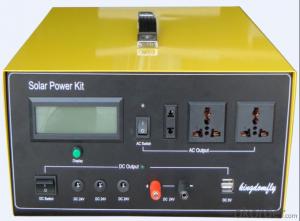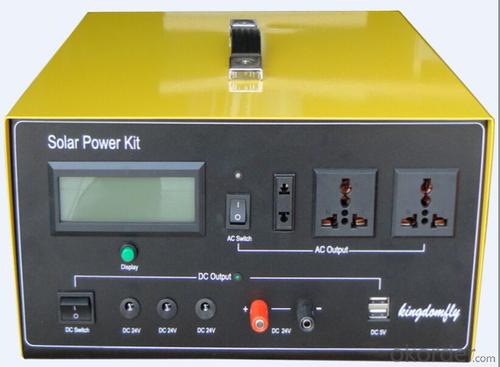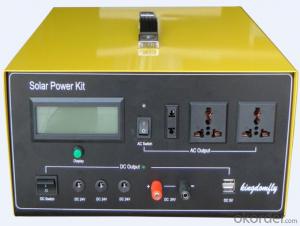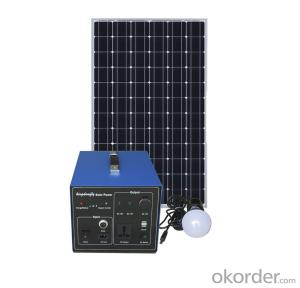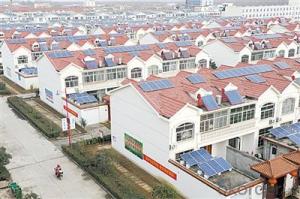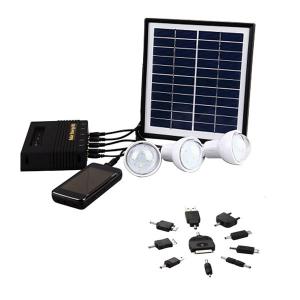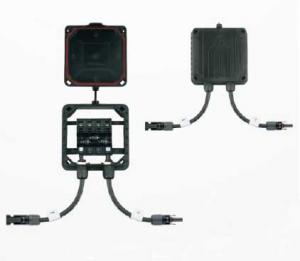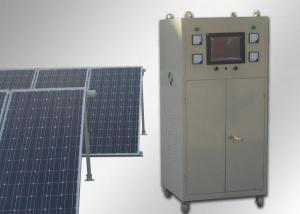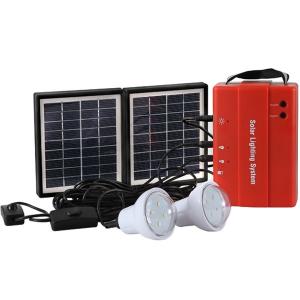Residential Solar Energy Systems - Household Solar Power Kit Hot Selling SPK_P1000
- Loading Port:
- China main port
- Payment Terms:
- TT OR LC
- Min Order Qty:
- 3 pc
- Supply Capability:
- 10000 pc/month
OKorder Service Pledge
OKorder Financial Service
You Might Also Like
Main Information
KDF SPK_P1000 This product is high performance,family used portable solar power system,which can receive energy and store it in battery outside connected to SPK by solar energy on sunny day,and supplies electric power for varies appliances such as electric fan,lighting lamps, television, portable computer etc.It can supply power for both DC and AC electric application .It’s very helpful and useful for home electric supply.
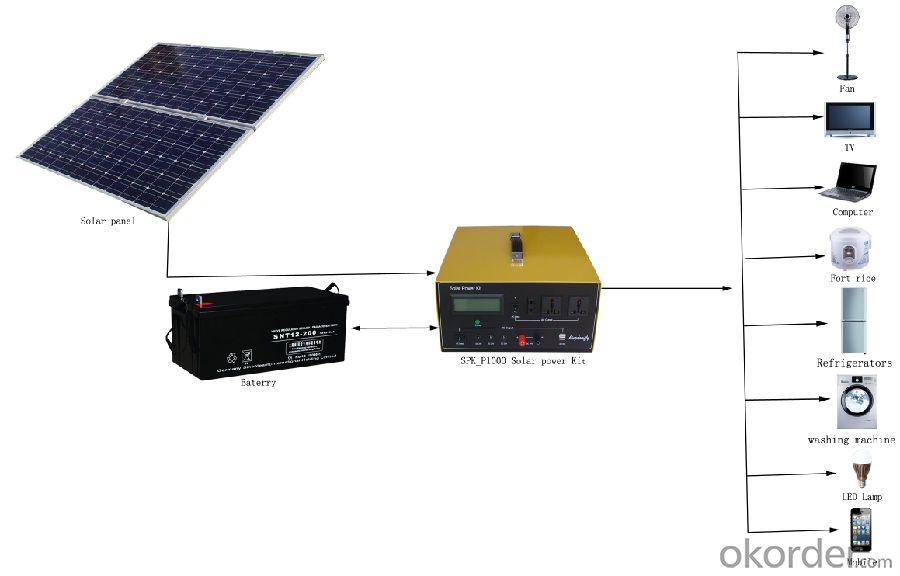
Features:
◆ Battery puts outside connected to the SPK for user to choose battery in recommended range, and easily to exchange battery.
◆ Both DC and AC output
◆ Solar Feedback Circuit Protection
◆ Output Short-circuit Protection
◆ Solar「+」「-」anti-access protection
◆ Output「+」「-」anti-access protection
◆ Over Charged Protection
◆ Over Discharged Protection
◆ Over Load Protection
◆ Over-Temperature Protection
Technical parameters
Specification | Value/Material | |
Item No. KDF | SPK_P1000 | |
Solar Recommended | Specification | Poly silicon |
Working Voltage/Power | 36V/80W~500W | |
Battery Recommended | Rated Voltage/Capacity | 24V50AH~200AH |
Cycle Number | 80% Deep Cycle Number:500 70% Cycle Number:800 | |
Working Temperature | Short Period(one Month):-20~50℃Long Period(Six Months):-10~45℃ | |
Charging Controller | Operating Voltage | 24V |
Input Voltage | 34.6V~42V | |
Input current | MAX:20A | |
Power Consumption | MAX: 15mA | |
Low Voltage Disconnect(LVD) | 21.6V | |
Low Voltage Reconnect(LVR) | 24.6V | |
High Voltage Discharge( HVC) | 29.2V | |
High Voltage Recharge(HVR) | 27.6V | |
Temperature Protection | 60℃ | |
DC Output | DC output & Application | USB 5V2A |
DC output & Application | DC 24V | |
AC Output | Output Wave | Pure sine wave |
Input Voltage | 22V~30V | |
Output Voltage | 220V±10% | |
Output Frequency | 60Hz±2Hz/50Hz±2Hz | |
Rated Output Power | 1000W | |
Maximum VA | 2000VA | |
Maximum Efficiency | 88% | |
Temperature | 0-40℃ | |
Over Temperature | 60℃~70℃ | |
Low Voltage Alarm | 22V | |
Low Voltage Shut off | 21V | |
High Voltage Shut off | 30V | |
Package | Set size | 350*449*227mm |
Set N·W | 7.2kg | |
Set N·W | 5.2kg | |
LCD_Display
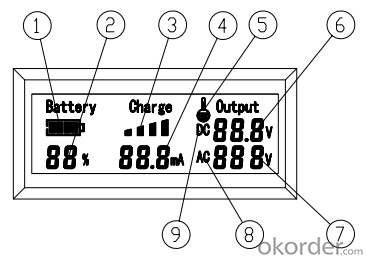
No. | Name | Function |
1 | Battery Icon | To show the Volume of the Battery |
2 | Date of % | To show the percent of the Battery |
3 | Charging Icon | To show the charging condition |
4 | Current | To show the value of charge current |
5 | Temperature Icon | Temperature Alarm |
6 | Date of Voltage | To Show the Value of DC output voltage |
7 | Date of Voltage | To Show the Value of AC output voltage |
8 | AC Icon | AC output |
9 | DC Icon | DC output |
- Q: Are there any risks of electrical grounding issues with solar energy systems?
- Solar energy systems can pose several risks due to electrical grounding issues. One major risk is the potential for electric shock, which occurs when the grounding system is not correctly installed or maintained. This can cause a buildup of electrical current, leading to contact with live electrical components and subsequent shock. Another risk is the possibility of fire. When the grounding system is improperly installed, it can result in electrical arcing, which can ignite a fire. This is especially hazardous as solar energy systems are often situated on rooftops, making it easier for a fire to rapidly spread throughout the entire building. Furthermore, a faulty grounding system can cause damage to the solar energy system itself. Without proper grounding, electrical surges and fluctuations can occur, harming sensitive components like inverters and batteries. To mitigate these risks, it is essential to ensure the proper installation and regular inspection and maintenance of the grounding system in a solar energy system. This involves using appropriate grounding equipment like grounding rods or conductors, as well as ensuring all connections are secure and free from corrosion. Regular testing should also be carried out to assess the effectiveness of the grounding system. It is advisable to enlist the services of a qualified professional for the installation and maintenance of the grounding system to minimize the hazards associated with electrical grounding issues in solar energy systems.
- Q: Can a solar energy system be used in areas prone to earthquakes?
- Indeed, areas prone to earthquakes can employ a solar energy system. Solar panels are specifically crafted to endure diverse environmental circumstances, including seismic activity. The mounting systems employed for solar panels are commonly engineered to comply with specified building codes and standards, guaranteeing their resilience against earthquakes. Furthermore, solar panels necessitate no movable components, rendering them less vulnerable to harm during seismic events. Nonetheless, it is crucial to acknowledge that the installation and design of the solar energy system must adhere to local regulations and building codes to ensure its effective resistance against earthquakes.
- Q: Can solar energy systems be used in powering hospitals or healthcare facilities?
- Yes, solar energy systems can be used to power hospitals or healthcare facilities. Solar panels can generate electricity that can be used to run essential medical equipment, lighting, heating, and cooling systems, among other energy needs. This not only reduces reliance on grid electricity but also provides a sustainable and reliable source of power, particularly in remote or off-grid areas. Additionally, solar energy systems can help hospitals save on energy costs and contribute to a greener and more sustainable healthcare sector.
- Q: Can a solar energy system be installed in a desert environment?
- Yes, a solar energy system can be installed in a desert environment. In fact, deserts are ideal locations for solar power generation due to the ample sunlight and lack of shading. The high temperatures in deserts can also increase the efficiency of solar panels.
- Q: Can solar energy systems be used in areas with high levels of natural disasters?
- Solar energy systems are indeed suitable for use in areas that frequently experience natural disasters. In fact, these systems can prove to be particularly advantageous in such regions. Unlike traditional power grids, which are susceptible to damage caused by natural disasters, solar energy systems are decentralized and can be easily installed on rooftops or in small arrays. This feature makes them more resilient to disruptions caused by events like hurricanes, earthquakes, or floods. In regions prone to hurricanes or severe storms, solar panels can be installed using mounts and brackets that are specifically designed to withstand high winds. Additionally, solar panels are built to be durable and can withstand hail, thereby minimizing damage during extreme weather conditions. In areas susceptible to earthquakes, solar energy systems can be installed with reinforced mounting systems and structural enhancements to ensure stability during seismic activity. Moreover, solar panels are typically lightweight and flexible, which reduces the risk of structural damage compared to other types of infrastructure. In regions that are prone to flooding, solar panels can be elevated or installed on floating platforms to prevent damage and maintain functionality during periods of high water levels. Furthermore, solar energy systems can provide a reliable source of power when conventional power grids are disrupted due to flooding. Furthermore, solar energy systems can aid in the faster recovery of communities after a natural disaster. By generating electricity locally, solar panels can power critical infrastructure such as emergency shelters, hospitals, and communication systems. This ensures the continuity of essential services during and after a disaster. Overall, solar energy systems offer distinct advantages in areas with high levels of natural disasters. Their decentralized nature, durability, and ability to provide reliable power make them a viable and resilient solution for meeting energy needs in such regions.
- Q: Can solar energy systems be used for powering aquaculture systems?
- Aquaculture systems can indeed be powered by solar energy. Solar power is a sustainable and renewable source of energy that can be utilized to generate electricity. This electricity can then be employed to operate different components of aquaculture systems, including water pumps, aerators, heaters, and lighting. The utilization of solar energy in aquaculture systems presents several advantages. Firstly, it decreases dependence on finite traditional fossil fuels, which contribute to both environmental pollution and climate change. By adopting solar power, aquaculture systems can significantly decrease their carbon footprint and contribute to a cleaner and more environmentally friendly energy future. Secondly, solar energy is abundantly available in numerous regions worldwide. By harnessing the sun's power, aquaculture systems can function independently of the electricity grid, benefiting remote areas that can now engage in sustainable aquaculture practices. Thirdly, solar energy systems offer long-term cost savings. Although the initial setup and installation costs may be higher compared to conventional energy sources, solar energy systems have significantly lower operational expenses. Once the system is installed, solar power is essentially free, and maintenance costs are minimal. This can result in substantial savings over time, making solar-powered aquaculture systems a financially viable choice. Lastly, solar energy systems can be integrated with other renewable energy technologies, such as battery storage systems. This enables surplus solar energy to be stored and utilized during periods of low sunlight, ensuring a consistent and reliable power supply for aquaculture systems. In conclusion, solar energy systems are an effective means of powering aquaculture systems, offering numerous benefits including environmental sustainability, energy independence, cost savings, and integration with other renewable energy technologies.
- Q: How much does a solar energy system cost?
- The cost of a solar energy system can vary depending on various factors such as the size of the system, the location, and any additional equipment or services required. On average, a residential solar energy system can range from $10,000 to $30,000, but it is recommended to consult with a solar installer to get a more accurate cost estimate based on specific requirements.
- Q: Can solar energy systems be used for powering electric vehicle carpooling services?
- Yes, solar energy systems can be used to power electric vehicle carpooling services. Solar energy systems generate electricity by converting sunlight into usable energy, which can be used to charge electric vehicles. By installing solar panels on the carpooling service's parking lot or charging stations, the vehicles can be charged directly from the sun's energy. This not only reduces the carbon footprint of the carpooling service but also helps in promoting renewable energy usage. Additionally, solar-powered carpooling services can benefit from reduced electricity costs as they would rely less on the grid for charging the vehicles.
- Q: Can a solar energy system be installed on a sloped roof?
- Yes, a solar energy system can be installed on a sloped roof. In fact, many solar installations are done on sloped roofs as long as the angle of the roof is within an acceptable range for optimal solar production. The panels can be mounted on racks or brackets that are specifically designed to be installed on sloped surfaces, allowing for efficient utilization of solar energy.
- Q: Can solar energy systems be combined with energy storage technologies like batteries?
- Yes, solar energy systems can be combined with energy storage technologies like batteries. This integration allows excess energy generated by solar panels to be stored in batteries for later use, providing a reliable and continuous power supply even when the sun is not shining.
Send your message to us
Residential Solar Energy Systems - Household Solar Power Kit Hot Selling SPK_P1000
- Loading Port:
- China main port
- Payment Terms:
- TT OR LC
- Min Order Qty:
- 3 pc
- Supply Capability:
- 10000 pc/month
OKorder Service Pledge
OKorder Financial Service
Similar products
Hot products
Hot Searches
Related keywords
